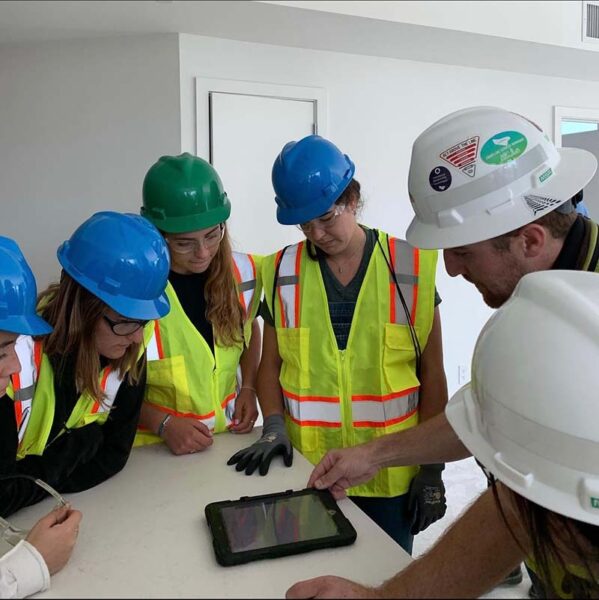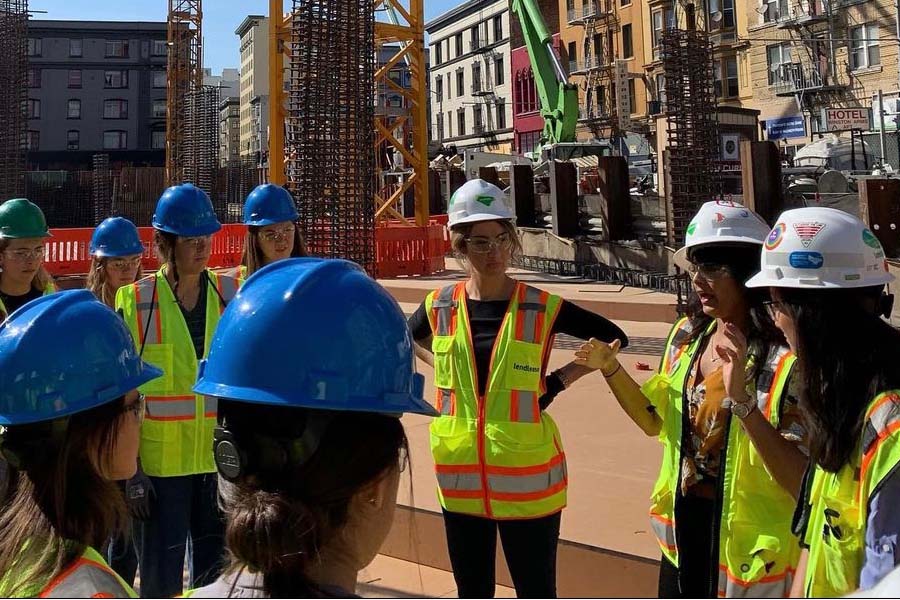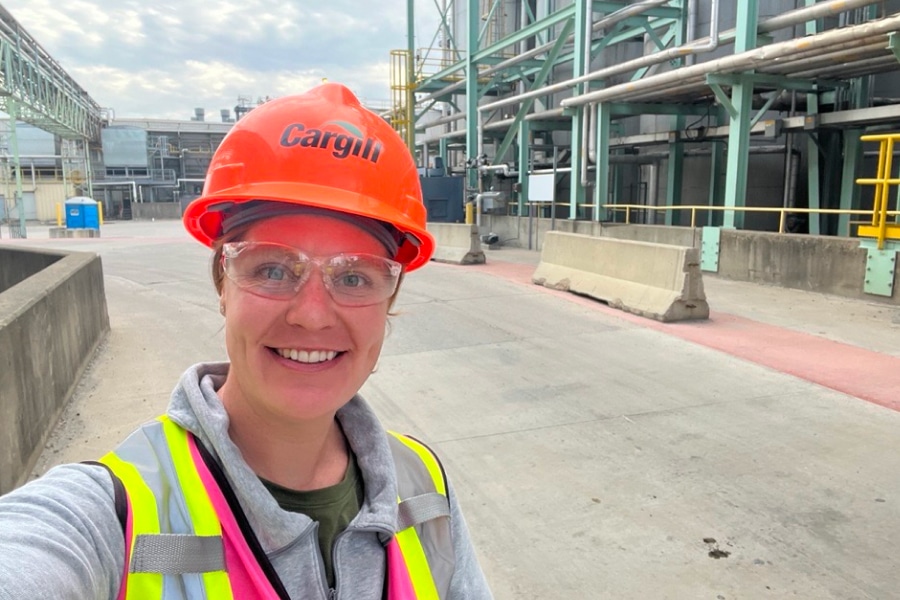Most construction professionals are aware of the challenges facing women in the industry.
With just short of 11% of the construction workforce, it can be difficult for them to find mentorship and support within construction. But as the need to recruit top-level talent grows, it’s vital that construction, engineering and architecture firms adapt to attract more women to construction—and help empower them to thrive on the job.
The Cal Poly Women in Construction club prides itself on doing just that. We spoke with professor Stacey Kolegraff about how the club is helping college-aged women find mentorship and support as they enter the industry.
Challenges in common
Kolegraff said she was inspired to support the founding of the Cal Poly Women in Construction club partially from a desire to continue the traditions of mentorship that helped her get her start in the industry.
“I graduated in 2002 and I had a great teacher who was a great mentor for me,” she said. “But she also painted a bleak picture of my future. What she told me and many of the other young women in our department was basically that when you get into the working world, there were rules you had to follow in order to be successful. You never talk about your family or your personal life. You never dress any differently than the people who you’re working with. You never wear a dress or a skirt. Basically, you are sexless.”

Kolegraff’s mentor said that identifying too much with your femininity on the jobsite could prevent people from taking you seriously. “She said they don’t see you as a colleague. They see you as a female colleague,” Kolegraff said.
For most of her career, Kolegraff built her career path by following those rules. “I was successful,” she said. “I went on jobsites. I dressed like the guys. I was a tomboy growing up, and I never wore skirts anyway, so I fit in. That’s the whole thing—assimilate or die. You fit in.”
But once she started teaching the young people who would one day make their careers in construction, Kolegraff knew the old advice wouldn’t cut it anymore. “Honestly, it was a very lonely existence,” she said. “I could not talk. You come to work and you cannot give 100% of yourself every day. You cannot be authentic because you’re hiding this part of your personality.”
Kolegraff knew her students deserved better. She wanted to help support them as they forged their career path in the industry she was passionate about, finding success in construction while remaining true to their authenticity.
Preparing students for the real world
Although she had worked to support students individually for her whole career, Kolegraff never imagined she would be a faculty advisor for a women in construction club.
“When I was a student in the construction management department, I was actually kind of anti an affinity group club,” she said. “I didn’t want to be recognized as a woman in construction. I always just wanted to be a person in construction. So for me it was kind of hard to get over that and really see the need that our women were expressing. I had to get over my own personal issues.”
What ultimately made Kolegraff take the leap was the feedback she received from her former students.
“I had been teaching in the department for a few years, and some of my alumni were coming back and talking about some challenges that they had seen in the industry,” Kolegraff said. “I heard the same stories from my internship students. Most of our students work internships over the summer, and a lot of them were coming back with stories of things that were happening to them that were just not OK, and they weren’t sure how to handle it.”
While the students said they seldom faced explicit discrimination or sexual harassment, the more subtle forms of “othering” they experienced left them at a loss for how to respond. “I would say that it was very limited blatant discrimination,” Kolegraff said. “It was a million small social things that, honestly, I don’t think men realize make a difference. But our girls did realize it, and they saw that they were being excluded in a way that led to them missing out on opportunities.”
Kolegraff realized that the best thing she could do as a mentor and educator was to create a place where students could seek mentorship and prepare themselves for jobsite challenges. “I realized we needed a better support network,” she said. “If it’s happening to one person, it’s happening to another. Together, we can create a community of support where students can assist each other in navigating the challenges and questions they confront, and know they’re not alone.”
More than just a social club

From day one, it was important to Kolegraff that the Women in Construction club helped its members build tangible, real-world skills. “What I challenged our leaders to do is not just develop it as a social opportunity,” she said. “Let’s make it so that it’s competency based as well. We’re here to kind of air our grievances, but also to raise up and empower the people within our department, not just women, but everybody.”
With Kolegraff’s support, the club has placed competency at its core, leading resume and professionalism workshops and trying to teach members how to read plans and drawings and work on many other key professional skills. They go on field trips every semester, visiting major construction companies around Cal Poly’s campus, in the Bay Area and beyond. And they’re using those skills and connections to help inspire the next generation of female construction leaders.
“We’ve developed a day activity with local Girl Scouts and gone to high schools to talk about career opportunities,” Kolegraff said. “It’s important for us to have mentorship at all levels and build a lasting partnership with our community. Every year they’ve just been doing more and more and more. It’s just been an amazing group of women who have taken leadership with this club, developed mentorship opportunities, developed training sessions and seminars, and just helped with overall connection within the department, as well as just feelings of self-confidence throughout.”
According to a study developed by Reagan Milligan, a current member of the Women in Construction club, that positive impact has already begun to take hold. “She found that confidence increased,” Kolegraff said. “Everybody who participated in the club found their confidence and their sense of inclusion increased. They had great experiences and felt like this club specifically was beneficial to them.”
As the first generations of the Women in Construction club have graduated and gone on to impressive careers working for major construction industry firms, often starting support groups or mentorship circles in their own workplaces, Kolegraff is proud of the legacy she has helped build. Ultimately, she hopes that their work can prove a model for the industry as a whole.
“The industry has changed over the last 20 years because people have been talking to each other,” she said. “There has been more support. We need more women, and women have great talent, and I think there’s a recognition of this fact. I think the power of having clubs like this is not just to say hey, we’re women in construction and we’re going to kick ass. It’s hey, we’re women in construction. We’re here to learn. We’re here to support each other. Let’s talk about gender in construction, and what that looks like and how we can actually create those inclusive spaces and create that language.”












